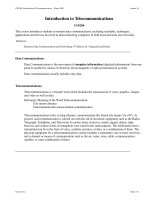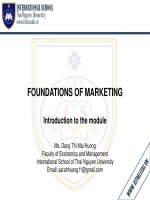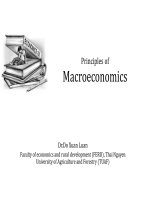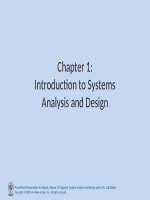1. Lecture 1 - Introduction to Research Method
Bạn đang xem bản rút gọn của tài liệu. Xem và tải ngay bản đầy đủ của tài liệu tại đây (738.78 KB, 52 trang )
Lecture 1 –
Introduction to
research
methodology
What is research?
• The systematic investigation into and study of materials and
sources in order to establish facts and reach new conclusions.
• Searching it again and again means Re-search. Research is
defined as human activity based on intellectual application in
the investigation of matter.
• The primary purpose for applied research is discovering,
interpreting, and the development of methods and systems
for the advancement of human knowledge on a wide variety
of scientific matters of our world and the universe
Elements of good research?
1. Clearly defined Purpose
•The problem to be studied should be stated
clearly and unambiguously.
•The statement of the problem (usually 1-2
pages) should include its scope, and the precise
meanings of all words and terms significant to
the research.
Elements of good research?
Elements of good research?
Elements of good research?
Elements of good research?
Elements of good research?
Elements of good research?
Elements of good research?
Elements of good research?
The Research Process?
1. Define the research problem
– Formulate and clarify the research topic.
– Develop research objectives & questions.
– Identify scope and significance of the study.
2. Critically review the literature
– Review concepts and theories.
– Review previous study findings.
– Develop a theoretical/conceptual framework.
The Research Process?
3. Formulate your research design
– Understand your philosophy and approach.
– Develop data collection and sampling design.
– Develop instrument and pilot-test it.
4. Collect data
– Negotiate access.
– Observe ethical considerations.
– Aim for data completeness.
The Research Process?
5. Analyse and interpret the data
– Prepare data for analysis.
– Apply appropriate analytical techniques.
– Use suitable data presentation formats.
6. Report-writing and presentation
– Address your research questions.
– Relate your results/findings to the literature
(theories and previous studies).
– Provide management recommendations.
1. Defining the research
problem
• A research problem can be defined as any situation where a
gap exists between the actual and desired ideal states.
• It could be a management dilemma or difficulty which a
researcher identifies in the context of either a theoretical or
practical situation and wants to obtain a solution or
explanation for the same.
• A research problem is often triggered by a question, curiosity
or uncertainty in the mind of the researcher regarding some
aspect of the business/organizational environment.
1. Defining the research
problem
• This is followed by exploration of relevant published
sources on the subject.
• An analytical review of existing literature helps the
researcher to clarify the overall research question or
research purpose.
• In one sentence the researcher should be able to say what
is to be achieved by conducting the study.
1. Defining the research
problem
Examples
1. The purpose of the study is to identify and analyze the
factors that affect the performance of women entrepreneurs
in Mekong delta.
2. The objective of the study was to establish the talent
retention strategies of Generation Z employees in the Viettel
company.
3.....
1. Defining the research
problem
The problem statement:
•The problem statement introduces the key problem that is
addressed in the research study. It is a clear, precise and
succinct statement of the specific issue that a researcher
wishes to investigate.
•In addition, is it relevant, feasible and interesting?
E.g:
• Climate change seriously affect farmers’ income;
• Shirmp mortality rate is increasing....
1. Defining the research
problem
Research objectives and questions:
•The objectives constitute the subcomponents which
together constitute the overall research question/research
purpose.
•In developing research questions, consider:
– Internal environment (organization).
– External environment (industry).
1. Defining the research
problem
Research objectives and questions:
Example:
Research Purpose: The objective of the study is to
determine talent retention strategies of Generation Z
employees in the Viettel company.
Research objectives:
1. To identify and analyze the retention factors as perceived by Generation Z employees.
2. To analyze the retention strategies used by mobile operator employers in Viettel for Gen Z
employees.
4. To propose recommendations for Gen Z retention strategies in the mobile telephony industry.
1. Defining the research
problem
Research objectives:
The formulation of objectives will help you to:
– Focus the study.
– Avoid the collection of unnecessary data.
– Organise the study into clearly defined
phases (process) and sections (structure).
1. Defining the research
problem
Research objectives:
Note:
•In the examination of your research project, the results will
be evaluated by the objectives. Clear objectives therefore
greatly enhance the successful evaluation of your research
project.
=> Research questions follow directly from research
objectives.
1. Defining the research
problem
Examples:
•Research Objective 1: To establish the retention rate
of Generation Z employees in the Viettel company.
• Research Question 1: What is the retention rate of Generation Z employees in Viettel?
•Research Objective 2: To identify and analyze the
retention factors as perceived by Generation Z
employees.
• Research Question 2: What are the factors affecting retention as perceived by Generation Z
employees? How do they affect the retention of Gen Z employees?
1. Defining the research
problem
Examples:
• Research Objective 3: To analyze the
retention strategies used by Viettel for Gen
Z employees.
• Research Question 3: What strategies have Viettel has put in place to retain
Gen Z employees?
2. Critically review the
literature
Why doing the literature review?
– Review concepts and theories.
– Review previous study findings.
– Develop a theoretical/conceptual
framework.









